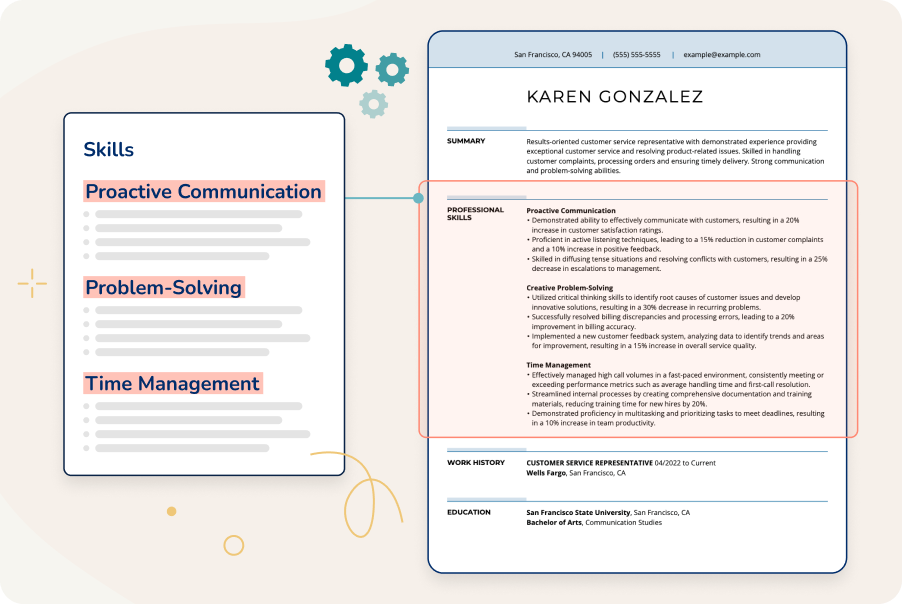Master the STAR Method: Tips, Questions & Answer Examples

Our customers have been hired at: *Foot Note
Interviews can be unpredictable, but one question type is almost guaranteed to come up: behavioral questions.
Employers want to know how you've handled past challenges to predict future performance. "Tell me about a time you dealt with a difficult situation." "Give an example of a time you worked under pressure." These questions can feel overwhelming — unless you have a strategy.
That's where the STAR method comes in. It's a structured way to craft clear, concise, and compelling responses highlighting your skills and experience.
Jump to the following sections:
What Is the STAR Method?
The STAR method of interviewing is a technique for answering interview questions. This method is particularly effective with behavioral interview questions, yet it can be used with any questions that require storytelling to highlight what skills you bring to the table.
“STAR” is an acronym for “Situation-Task-Action-Result.” This method structures your answers to ensure you’re highlighting job-relevant skills and showcasing how you used them.
Following this simple framework, you can confidently navigate tough questions, demonstrate your problem-solving abilities, and leave a lasting impression.
Here’s how the STAR method for interviewing works:
Situation: Describe the situation or problem you encountered.
Task: Explain the task or objective that you need to achieve.
Action: Detail the specific actions you took to solve the problem.
Result: Describe the outcome of your actions and the impact it had.
Using the STAR method in an interview helps hiring managers evaluate your ability to handle specific situations, think critically, problem-solve, and communicate effectively.
What are behavioral interview questions?
Behavioral interview questions are those that ask candidates to describe a situation or scenario that they have encountered in the past and to explain how they handled it. For example:
- Tell me about a time you had to resolve a conflict at work.
- Describe a situation where you had to adapt to a significant change.
- Give an example of a time when you went above and beyond to meet a deadline.
- Tell me about a time you made a mistake at work. How did you handle it?
- Describe a situation where you had to work with a difficult team member.
Preparing for the STAR Interview Method
- Research the company: Conduct thorough research on the company, its culture, values, and recent achievements. This knowledge will allow you to align your examples with the company's goals and values, showcasing your fit.
- Study the job description: Carefully review the job description and identify the essential skills, experiences, and qualities the employer seeks. This will help you tailor your examples to align with their requirements.
- Identify relevant experiences: Reflect on your past experiences, both professional and personal, and identify situations that demonstrate your skills and abilities. Look for examples that highlight problem-solving skills, leadership, teamwork, adaptability, and other qualities sought by the employer.
- Review common interview questions: Research the industry and specific job position to familiarize yourself with common behavioral interview questions.
- Prepare specific examples: Develop a list of specific examples for each competency or skill you want to showcase. For each example, outline the Situation, Task, Action taken, and Result achieved.
- Practice storytelling: Rehearse delivering your examples concisely, engagingly, and confidently. Focus on telling a compelling story that highlights your skills and demonstrates your ability to handle challenges.
- Conduct mock interviews: Enlist the help of a friend or mentor to conduct mock interviews using STAR method questions. This will give you an opportunity to practice your responses, receive feedback, and refine your storytelling techniques.
How to Use the STAR Method for Interviews
During STAR method interviews, keep the acronym in mind. Be clear and concise. You can use phrases to incorporate the STAR format into your answer to keep track of your story, for example:
- Situation:
- “The situation was…”
- “The issue we were facing…”
- “The problem we tackled…”
- Task:
- “In my role as a…”
- “I was responsible for…”
- “I was working as…”
- Action:
- “I led…”
- “We decided…”
- “I began…”’
- “I researched and concluded we could…”
- Result:
- “As a result…”
- “The outcome was…”
Let’s take a look at how to use the STAR method of interviewing step by step.
STEP 1
Describe the situation: Set the scene and explain the issue you faced. The employer needs to know what prompted you to use your skills. Stay on topic and avoid unnecessary details.
Let’s say the employer asked, “Can you describe a time when you had to solve a complex problem in your previous role as a software engineer?” You could say:
STEP 2
Define your task: Explain your role at the time of the problem. Simply state your position and provide a quick overview of your responsibilities concerning the issue. No need to use a long description, a simple answer will work well:
“As a software engineer, I was a team leader and had to minimize any potential timeline impact.”
STEP 3
Discuss the action: Now that the employers know the problem and why you were involved, it’s time to let your skills shine.
For example, you could say:
“I conducted an in-depth analysis of the code to determine the root cause of the issue. Then, I met with the team to identify potential solutions. Over the next several days, I worked closely with the development team to implement the necessary changes while ensuring that we maintained a high level of quality in our work. I prioritized regular code reviews and testing to catch any issues early on in the process and made sure that all stakeholders were kept up to date on our progress.”In this answer, you demonstrate the independent thinking, leadership, decision-making, coding expertise, and adaptability skills this employer needs.
Whether you find them during your research or from the job description, ensure your “Action” includes your strongest job-relevant skills.
STEP 4
Share the results: Like the task, this outcome should be a simple answer letting the employer know that your skills worked and you were able to find a solution to the problem. For example:
“We were able to resolve the issue successfully while delivering the project on time. The client was extremely satisfied with our work and decided to hire the company for a future project.”
The STAR method is made to shine a light on your potential. This is why it is important to use positive examples. If you have an example with a negative outcome that still highlights your skills, you can use it by framing it in a positive light.
For example, you learned a new skill to help your career, you showed your resilience under duress, or your failed attempt at a solution helped find another more pressing issue, and so on.
STAR Method Interview Questions and Answers
Now that you know how to use the STAR method technique, let’s see it in action with sample answers for common behavioral interview questions.
Situation: During a busy shift in the emergency room, I managed multiple patients with varying degrees of need, all while ensuring that each patient received timely and appropriate care. With limited resources and a constant influx of patients, I needed to be able to manage my time effectively and prioritize tasks accordingly.
Task: My task was to juggle multiple deadlines and ensure that each patient received the care they needed promptly and appropriately.
Action: To manage multiple patients effectively, I first assessed each patient's needs and prioritized my tasks based on the urgency of each situation. I communicated effectively with the other nurses and doctors on my team to ensure we were all on the same page regarding each patient's care plan. Additionally, I used organizational tools such as notepads and checklists to keep track of each patient's status and progress.
Result: As a result of my careful planning and effective time management skills, I was able to juggle multiple deadlines successfully and provide excellent care to all of my patients. I received positive feedback from patients and colleagues on my ability to handle busy shifts easily and professionally.
Give Me an Example of a Time When You Solved a Problem With Your Research Skills
Situation: In my previous teaching position, I noticed that many of my students were struggling with a particular math concept, despite my efforts to explain it in different ways. I knew that I needed to find alternative teaching methods to help my students better understand the concept.
Task: I had to research different teaching methods and develop a new strategy to help my students understand math concepts more effectively.
Action: I consulted academic journals and textbooks on math education to understand better the learning process and how students can best be supported. I also engaged in discussions with other teachers and experts in the field to gain insights and perspectives. Based on my research, I developed a new teaching strategy that incorporated hands-on activities and visual aids to supplement traditional instruction.
Result: My students began to understand the math concepts more effectively. They became more engaged in class and more confident in their abilities, which improved their performance overall. Additionally, my colleagues and administrators recognized my initiative and ingenuity in addressing the problem.
Give Me a Specific Occasion in Which You Conformed to a Policy With Which You Did Not Agree
Situation: At my previous restaurant job, there was a policy that all waitstaff was required to wear a specific uniform, including a branded polo shirt and khaki pants. While I appreciated the desire for a professional appearance, I found the outfit unflattering and uncomfortable.
Task: Despite my reservations about the uniform, I recognized the importance of conforming to company policies and presenting a consistent image to customers. I knew my job depended on adhering to these standards, regardless of my personal preferences.
Action: To comply with the policy, I wore the appropriate uniform whenever I was on shift. I even went a step further and found ways to make the uniform more comfortable, such as investing in high-quality, breathable fabrics and finding the right size and fit.
Result: By conforming to the uniform policy, I maintained a professional appearance and presented a consistent image to customers. Furthermore, I demonstrated my commitment to the company’s values and policies, which helped build trust and respect with my colleagues and superiors.
Situation: At my previous job as a customer service representative, I received a call from an angry customer who had just received a damaged product. The customer demanded an immediate refund and wanted to speak to a manager.
Task: As the first point of contact for the customer, it was my responsibility to de-escalate the situation, find a solution, and satisfy the customer while maintaining the company's policies and procedures.
Action: I took a deep breath, actively listened to the customer's concerns, and empathized with their frustration. I reviewed the company's return policy and offered a replacement product that would be shipped overnight at no additional cost. I also escalated the issue to the manager, who contacted the customer directly to further address their concerns.
Result: The customer was satisfied with the solution and thanked me for resolving the issue quickly and professionally. The company was able to retain the customer's business and avoid negative reviews or social media backlash.
Tell Me About a Time When You Were Forced to Think on Your Feet
Situation: In my previous job, I worked closely with a coworker with a different work style and approach than mine. This led to conflicts and disagreements on how to approach certain tasks.
Task: As a team, we were responsible for completing a project that required collaboration and effective communication, despite our conflicting work styles.
Action: To address the conflict, I initiated a conversation with my coworker to listen to their perspective, express my concerns, and find common ground. During the conversation, we identified our strengths and weaknesses and how to complement each other's skills. We also established clear expectations, boundaries, and deadlines for our tasks and established a communication plan to keep each other informed of progress and roadblocks.
Result: We could complete the project on time and meet our goals effectively by addressing the conflict and finding a resolution that worked for both of us. Additionally, we developed a stronger working relationship and mutual respect for each other's work styles and abilities.
Additional behavioral interview questions to prepare for before your interview:
- Describe a Project or Situation That Demonstrates Your Analytical Ability
- Tell Me About a Time When You Missed a Deadline for a Project
- Describe a Time When You Used Written Communication Skills to Get a Point Across
- Describe a Situation When You Had to Handle a Difficult Client
- Give Me an Example of How You Juggle Multiple Deadlines
Expert Tips for Using the STAR Method
- Understand the question: Listen carefully to the interviewer's question and make sure you fully understand what they are asking. If you are unsure, don't hesitate to ask for clarification before proceeding with your response.
- Be concise: Keep your responses focused and concise. Aim to provide enough detail to clearly illustrate your skills and experiences, but avoid rambling or going off on tangents.
- Highlight your role: Clearly articulate your individual role and contributions within the example. Emphasize how your actions made a difference and how you showcased your skills and abilities.
- Use metrics and results: Whenever possible, quantify your achievements and results to make your response more impactful. Numbers, percentages, or specific outcomes help demonstrate the value you brought to the situation.
- Be honest and authentic: It's important to be truthful and genuine in your responses. Don't exaggerate or fabricate examples. Instead, focus on providing accurate and meaningful examples that truly reflect your experiences and abilities.
- Connect to the job requirements: Tailor your examples to align with the specific skills and qualities the employer is seeking. Make connections between your experiences and the job requirements to demonstrate your fit for the role.
- Stay engaged and listen actively: While delivering your responses, maintain eye contact with the interviewer and show genuine interest in the conversation. Active listening will allow you to adjust your responses based on any follow-up questions or cues from the interviewer.
- Practice flexibility: Be prepared to adapt your examples to different types of questions. Even if the interviewer doesn't explicitly ask for a STAR method response, you can still use the framework to structure your answer and provide a well-rounded response.
Key Takeaways
- The STAR method stands for “Situation-Task-Action-Result,” and it is a technique for answering interview questions.
- In interviews, use the STAR method to structure your answer to different questions, particularly behavioral questions and other open-ended questions.
- To use the STAR interview technique, prepare by researching the employer and practicing with a trusted person.
- Always personalize your STAR interview answer to the employer's needs and include quantifiable achievements.
FAQ
Why is the STAR method a powerful structure to use when answering behavioral interview questions?
The STAR method is a powerful structure to use when answering behavioral interview questions for several reasons:
- Provides a clear structure: It enables you to organize your thoughts and deliver a well-structured response that is easy for the interviewer to follow.
- Offers concrete examples: This approach enables the interviewer to visualize your abilities and understand how you have handled similar situations in the past.
- Highlights your achievements: The STAR method emphasizes the Result component, which enables you to highlight your achievements and the impact of your actions.
- Easy to remember: The STAR method is easy to remember and apply, even in high-pressure situations. This approach enables you to deliver your responses with confidence and clarity, which can help you stand out from other candidates.
By mastering the STAR method, you can increase your chances of interview success and demonstrate your fit for the role.
How can I tailor my STAR responses to different types of interview questions?
Tailoring your STAR responses to different types of interview questions can help you deliver more effective and relevant responses. Here are some tips:
- Behavioral questions: Focus on the specific skills or competencies the interviewer seeks and tailor your response accordingly.
- Hypothetical/situational questions: To answer these questions, use the STAR method to describe a similar situation you have faced in the past and how you handled it.
- Technical questions: Describe a specific project or task where you applied your technical skills and how they contributed to the positive outcome.
- Goal-oriented questions: Detail a specific achievement that aligns with your goals. Be sure to explain the specific steps you took, the challenges you overcame, and the positive outcomes that resulted.
By tailoring your STAR responses to different types of interview questions, you can deliver more effective and relevant responses that showcase your qualifications to the interviewer.
Can the STAR method be used for group or panel interviews?
Absolutely! The STAR interview method structures your answers regardless of the interviewing technique. As long as you’re asked a question that requires storytelling, you can use the STAR method.
Can the STAR method be used for video interviews?
Yes, the STAR method can be used for video interviews. Here are some tips for using the STAR method in virtual interviews:
- Speak clearly and concisely: In a virtual interview, it’s important to speak clearly and concisely to ensure that your responses are easily understood. Use the STAR method to deliver structured and organized responses that get to the point quickly.
- Maintain good eye contact: In a virtual interview, maintaining good eye contact is essential to establish a connection with the interviewer. Look directly into the camera when speaking, rather than focusing on your own image or looking elsewhere on the screen.
- Practice active listening: In a virtual interview, it can be more challenging to pick up on nonverbal cues and signals. Practice active listening by carefully listening to the interviewer’s questions and responding directly to what they are asking.
- Test your technology beforehand: Before the virtual interview, make sure to test your internet connection, camera, and microphone. Ensure that you have a stable internet connection and that your audio and video are working properly.
The STAR method is a great tool for answering questions during a virtual interview, where clear and structured responses are important for effective communication.
How long should STAR interview answers be?
STAR interview answers should be long enough to provide a complete and detailed response while also being concise and relevant.
Ideally, your answer should be about one to four minutes long, but it can be longer or shorter depending on the complexity of the situation you are describing.
It’s important to remember that the interviewer is looking for specific information about your experience and skills, so be sure to provide enough detail and examples to demonstrate your abilities.
However, avoid going off on tangents or providing unnecessary information that doesn’t relate to the question being asked.
Can the STAR method be applied to resumes?
The STAR method can also be applied to your resume to showcase your accomplishments and qualifications in a structured way. Here are a few tips for crafting a STAR method resume:
- Identify relevant achievements: Review your work experience and identify specific achievements demonstrating your skills and qualifications for the position you are applying for. These could include projects you completed, goals you achieved, or problems you solved.
- Use the STAR method to describe your achievements: For each relevant achievement, use the STAR method to describe the Situation, Task, Action, and Result of the project or task. Be sure to focus on the specific skills or competencies the job requires and tailor your response accordingly.
- Quantify your achievements: Whenever possible, use numbers and data to quantify your achievements. For example, instead of saying “Increased sales,” say “Increased sales by 20% in six months by implementing a new marketing campaign.”
By using the STAR method in your resume, you can stand out to potential employers and demonstrate your value as a candidate. See our guide on how to write a resume for additional advice from career experts.
How we reviewed this article
Since 2012, we have helped more than 11 million job seekers. We want to make your career journey accessible and manageable through our services and Career Center’s how-to guides and tips. In our commitment to bring you a transparent process, we present our Editorial Process.
Our customers have been hired at:*Foot Note









